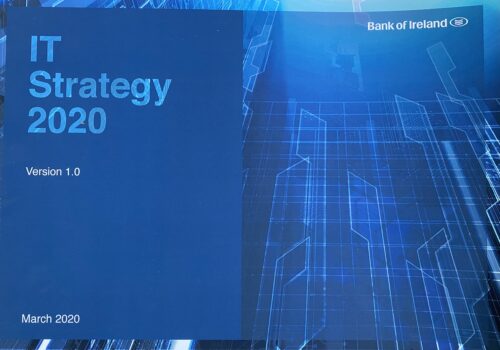Overview
The Bank of Ireland, has a long-established history, a strong domestic market share and is considered a pillar of the Irish national banking system.
The Bank of Ireland continues to modernise in response to customer demand, the onset of challenger banks and the need to manage down operating costs. They needed to develop a new IT strategy to address the modernisation agenda, fully aligned to the Business Goals and set out this vision to both the Board and the Regulator.
Client Challenges
- Reassess and redefine the vision to align IT to the future strategic direction of the Bank
- Document and validate a new IT reference architecture that to facilitate the development of the IT target end state
- Build out a set of key initiatives required to deliver the IT target end state and ensure this would be incorporated into the central transformation roadmap
- Communicate the IT response to a diverse set of stakeholders, including the Board of Directors, Regulators and Colleague community
- Embed those principles and establish the desired decision-making patterns within the organisation
What did we do?
Aveas were asked to own the development of a comprehensive IT Strategy, working with stakeholders from across the Bank to ensure that it was realistic and fully aligned with the business goals. This work included
- Strategy leadership, analysis and design services, ensuring industry and technology good practice.
- Breakdown of the Divisional Intent into IT Technology Pillars which helped to articulate the approach at a more tangible level:
- The Application Strategy – Key application capabilities and roadmaps
- The Technology Strategy – Foundations for the applications and information strategies
- The Operating Model Strategy – Illustrating the organisation, the people and their roles that discharge the processes and the governance
- The Information Strategy – Creation, storage and sharing of information and digital assets
- The Cyber Security Strategy – The organisations response to current and future security risk
- The IT Risk Management Strategy – Summary of the active risk management and compliance
- Support communication of the strategy to the Board of Directors, Regulators and Colleague Community was an essential part of the delivery and the successful outcomes.
What were the benefits?
- A new and very detailed IT strategy (This included an executive summary and a 125-page IT Strategy covering the breadth of the Technology Pillars as outlined above)
- An agreed set of IT reference architectures that facilitated the development of the IT target end state
- A set of key initiatives required to deliver the IT target end state and to embed the strategic principles and desired decision-making patterns within the organisation
- A roadmap setting out the approved journey
- A clear understanding at Board level and by the Regulator of the intent of the Bank for delivery of IT

